As the name suggests, Shubunkin goldfish is of Japanese origin and a colorful breed. They are colorful little creatures that get their name from their coloration and are also often referred to as calico goldfish or goldfish calico. Shubunkins and the rest of the goldfish species are from the Cyprinidae family and bred by Yoshigoro Akiyama by crossing the Calico telescope eye goldfish (for the color), the comet goldfish, and the common goldfish for the stature.
/GettyImages-1253432720-7d46c57589b44fb9ab1350ca94e68244.jpg)
Table of Contents
Shubunkin Goldfish Overview
One remarkable trait about the shubunkins is that they don’t possess teeth as many other animals do. Instead, their teeth are located in the back of their throats, also known as pharyngeal teeth. Due to their bright and multi-hued coloration, these fish are great additions to any pond or aquarium. They are similar to koi fish in appearance, but aquarists will know that a vast difference between the Shubunkin and the koi is the price tag.
If you are looking for an affordable yet just as beautiful addition to your aquarium, then Shubunkin is an excellent choice. They are available in most pet stores, can keep you company for years, and live up to their calico name with many color variations, including hints of blue!
| Information Chart | Shubunkin Goldfish |
|---|---|
| Care Level: | Easy to Medium |
| Temperament: | Peaceful |
| Color: | Red, yellow, white, orange, blue, and black |
| Lifespan: | 15 years |
| Size: | 12 inches (1 foot) |
| Family | Cyprinidae |
| Diet: | Omnivorous |
| Minimum Tank Size: | 75 gallons |
| Temperature: | 65-72 ºF, 18-22 ºC |
| Water Conditions: | pH levels from 6 to 8 |
| Tank Mate Compatibility | Fast, less timid, and peaceful fish |
Shubunkin Goldfish Care Level
Shubunkins are hardy fish that are easy to care for. They can get quite big (about a foot long) so having enough space is imperative for them to thrive. This is why shubunkins are kept in ponds, which can simulate their natural environment and have enough room to grow to their full potential.
We think you may be interested in Best Pond Liner
These peaceful freshwater fish are not demanding water conditions and can stay healthy with very little. Shubunkins come in many color variants, but blue (yes, blue) is the most coveted, sought-after, and expensive color of shubunkins. More on all of this later as we dive into more detail on these colorful fish.
Types of Shubunkin Goldfish
As per the experts, the calico marbling makes this goldfish quite different from other single-tailed goldfish. Now speaking about the types, you will see three different types of Shubunkins. These are London, Bristol, and American Shubunkin goldfish. Now, let’s talk about them in detail.
#1 American Shubunkins
Despite the name, many people think that the American Shubunkin goldfishes look pretty similar to the original goldfish that first breeders in Japan began with. That’s why some call this the Japanese Shubunkin.

Speaking more about the American shubunkins, they have a unique characteristic and multi-colored appearance. But you can distinguish them from the others by looking at their tails. If you look carefully, you will find that they have long and deeply forked tails compared to other variants. If you don’t consider the calico patterns, they will look like the Comet Goldfish.
#2 London Shubunkins
It is a fact that most of the aquarists love to keep London Shubunkins. They generally split the difference between Bristol and American Shubunkin.
Their appearance is generally calico colored, but you will find rounded tails with slender bodies when you observe them closely. Compared to the other Shubunkins, London Shubunkins have a wide variety of patterns. For your home aquarium, they can be a perfect option.
#3 Bristol Shubunkins
Among all the types of Shubunkin, Bristol Shubunkins will cost you more. Now, you might be wondering why? One of the primary reasons behind this is that these shubunkins are rare.
They have an attractive body shape and look very beautiful. If you mark closely, you can see that their tails have rounded lobes creating the letter “B.” But their fins are rounder and shorter compared to other Shubunkins.

Shubunkin goldfish generally display beautiful calico patterns in red, gold, black, blue, and orange. The stunning marbled look of Shubunkin perfectly mimics koi fish, and it has been seen that most aquarists prefer to add them to their community tanks to come up with the touch of koi fish.
Is Your Shubunkin Female Or Male?
Well, this can be quite confusing and challenging to decide whether you have a male or female Shubunkin goldfish as they all look the same. That doesn’t mean that it is entirely impossible. You will differentiate between the female and male Shubunkin goldfish during the breeding season.
You can try to observe the Shubunkins in your aquarium from the above. Female fish will generally look a little rounder and broader than male Shubunkins. Besides, when males are in breeding conditions, they generally develop pimples around the gill covers and heads. These are called breeding stars or tubercles.
Temperament And Behavior
Shubunkin, like a lot of other common goldfish, is friendly. They can get along with many other fish, aside from more aggressive species. They can get quite large, and they are also strong swimmers, contributing to their need for lots of room. They do well with other species and their own as they can be quite the social butterfly, but because they tend to outswim their tankmates and love to eat, you need to make sure there is plenty to go around.
When we say they love to eat, it is an understatement. These fish will clean up the tank and all the food you give, which helps maintain the tank or pond environment. It also minimizes the need for scavengers in the tank. You can find them swimming around the tank or dwelling at the bottom, picking up leftovers.
Some prefer to keep their Shubunkins on their own. However, these are social fish even though they don’t prefer to be together all the time. Shubunkins are like the company of a school.
You should keep at least two Shubunkins together but don’t forget to consider the tank size. For two Shubunkins, experts suggest using a 284 liter or 75-gallon tank.
Due to their faster appetites, the Shubunkin goldfish can easily outcompete others living in your aquarium. Sometimes, you can also find them roaming around the bottom of the fish tank to consume the missed scraps.
So, there is no need to add more scavengers into your aquarium. But you should always keep an eye on the other fish and make sure they are getting sufficient food.
Shubunkin Goldfish Appearance
Although the Shubunkin originates from Japan, the names that classify the most common shubunkins are named after cities miles away.
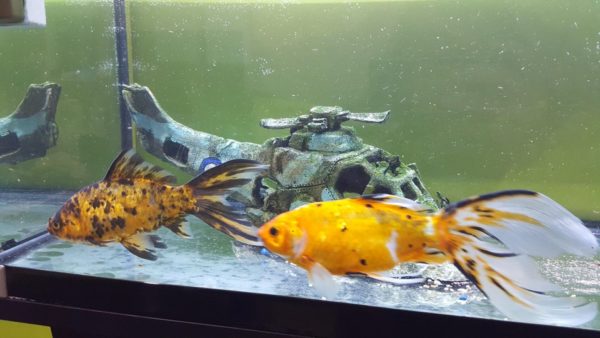
As discussed in the above section, the London Shubunkin is slimmer with more rounded fins, but the coloration is still the same (blue, red, black, white, orange, and yellow). The Bristol Shubunkin is also slim, but its fins are more distinctive. The original Shubunkin, the American or also referred to as the Japanese Shubunkin (a more proper name due to its origin), has a deeply forked tail that’s longer than the other types.
Shubunkins come in different patterns and calico coloration. Generally, when people hear “Calico,” they think about a cat. One of the primary reasons for such color is genetics.
Most Shubunkins have a beautiful spotted color. They can be a unique combination of orange, red, white, blue, black, or yellow.
Some Shubunkins come with long fins that take their appearance to a new level. When they swim, you can see their fins flowing with their movements.
One of the most exciting characteristics of Shubunkins is the unique blue coloration. This characteristic among the Shubunkins is scarce, and the cost of the fish is determined by considering this factor. As they are scarce, you will have to pay more for them.
Shubunkin Goldfish Size
How big does a Shubunkin goldfish get? They can get quite large, up to 12 inches (1 foot) long. The size does depend mainly on the environment and diet given to the shubunkins. In the right conditions, it can grow to this size.
The best thing about Shubunkin goldfish is that they can adapt to the size of their living environment. This is a significant evolutionary trait that all types of goldfish share. That allows them to endure overcrowding and drought in the wild. This can also significantly affect the growth of Shubunkin fish.
Remember that improperly tiny vessels, vases, and bowls can lead to poor health conditions in your Shubunkin goldfish.
If you go on perfect aquarium size, then you can expect your beautiful goldfish to grow around five to six inches. If you keep them in a pond and offer them maximum freedom, they can grow to their full potential. As mentioned above, they can attain a length of around 12 to 14 inches.
It has also been seen that a Shubunkin can grow up to 18 to 50 inches under proper conditions.
Color
Think of the shubunkin goldfish as a smaller version of koi. They come in many calico variations, each more unique than the last. They combine the following colors: red, yellow, white, orange, blue, and black. Like the comet goldfish, which also happens to be where they get it from, they can have long billowing tail fins that are gorgeous as they swim.
As mentioned before, blue is the most coveted color and the rarest. The bluer hues the shubunkin goldfish has, the more expensive and rarer it is. You will mostly find shubunkin goldfish with a white base and splashes of red, black, yellow, orange, and, if you are lucky, blue.
Lifespan of Shubunkin Goldfish
How long do Shubunkin goldfish live? Shubunkins are hardy fish that can live quite long. Goldfish, in general, if properly taken care of, are healthy fish that can live up to 20 years. Again, this largely depends on the environment and the level of care it receives. You can be sure that the fish will be with you for at least 10 years.
Even though Shubunkins are hardy fish, they need a pond or a proper tank size. Besides, you will have to maintain their water quality throughout the year. A slight change in their water quality can reduce their lifespan.
On the other hand, if you maintain a pristine water condition, offer sufficient swimming space, and provide them with good-quality fish foods, you can keep your Shubunkin swimming around the aquarium for around 30 years.
Feeding Shubunkin Goldfish
The Shubunkin goldfish is unique because it was bred in captivity and is a domestic species. Due to this, it’s hard to gauge what these goldfish would eat in the wild since all they have ever known is in captivity. If we compare them to other goldfish species or their ancestors, we can conclude that they ate whatever they could in the wild.
An accurate projection of their diet would include plants and floating materials, smaller crustaceans and insects, as well as whatever they can wrap their mouths around. This is why you need to be aware of what you place in the tank, but more on that later.
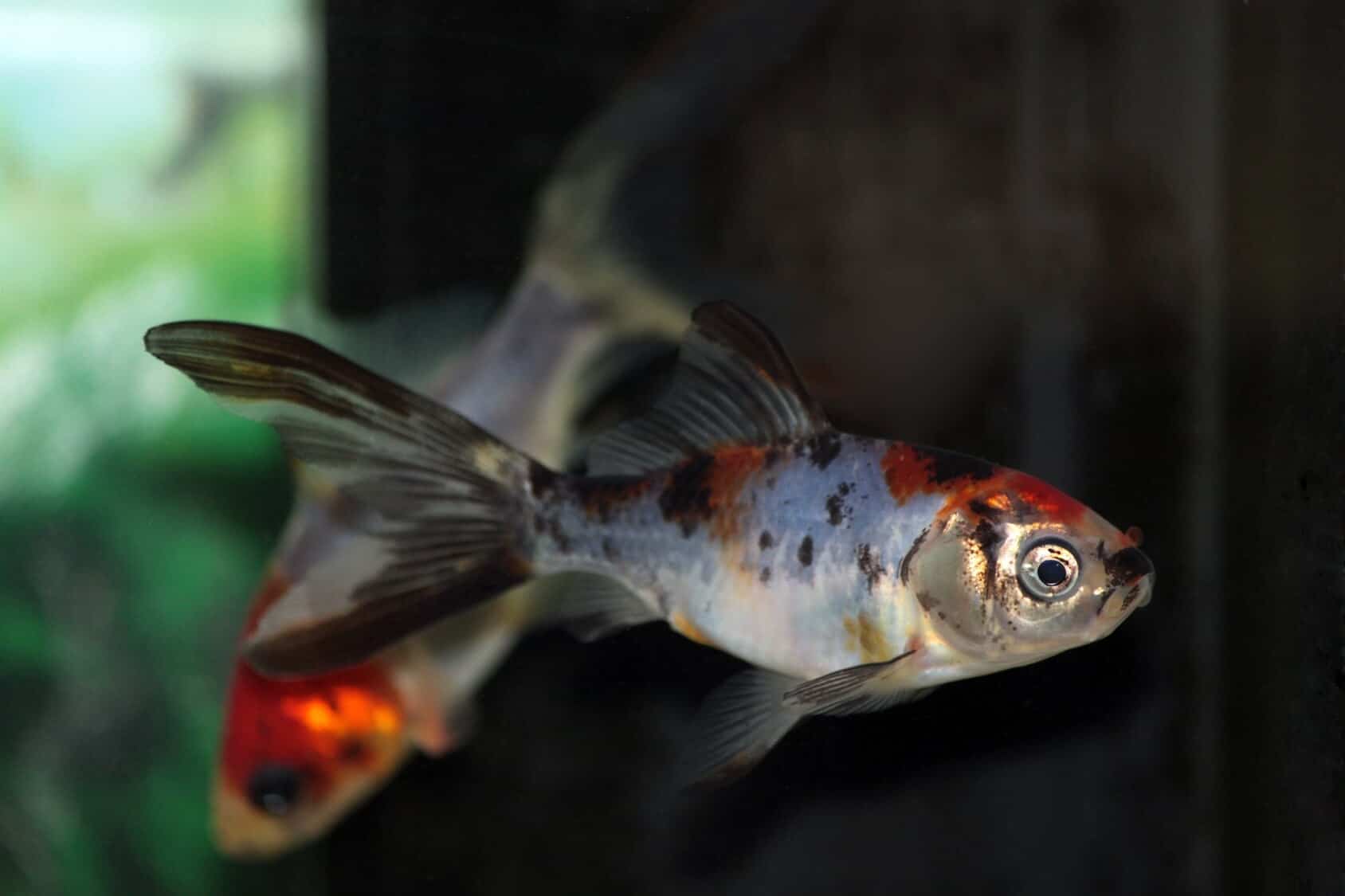
It can be challenging when feeding the shubunkin goldfish because you need to be more accurate with the portions. However, it does eliminate the need for scavengers and regular tank cleaning on the bright side. Thanks to their love of eating, you can give them anything. Pellets and flakes are a great place to start, but since they are omnivorous (both plant and meat-eating), we suggest supplementing their diet with the occasional treat.
Think about extra greens and frozen foods. They will appreciate the occasional bloodworm and shrimp in their diet.
The amount they can eat in two minutes will be enough for them. Provide them with high-quality proteins so that they can develop enough swimming power. You should keep switching between freeze-dried, fresh, and frozen options so that they can enjoy different varieties. Some popular options are:
- Krill
- Brine shrimp
- Bloodworms
As they love to nibble on vegetables and fruits, you can offer them water hyacinth, tomato, watermelon, lettuce, peas, cucumber, spinach, and orange.
Family
Like most other goldfish, the Shubunkins are freshwater from the Cyprinidae family.
Shubunkin Goldfish Care & Tank Set-Up
Tank Conditions for Shubunkin Goldfish
Larger fish will need more space; this is why a pond is most recommended instead of a tank. Unless you have enough space indoors or only plan to have 1 or 2 shubunkins, a pond is a way to go. It can make sure your Shubunkin has enough room, and the natural conditions of the outdoor environment will simulate what they are used to. The water flow should be slow and consistent, but shubunkins are tough and can handle the most subtle changes.
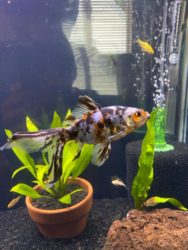
As we mentioned earlier, these fish love to eat. The substrate you place in the tank will need to be strong-rooted and fast-growing. As for tank liners, look for larger gravel and not sand since they can mistake it for food. The larger substrate will give it the chance to scavenge for leftovers like it would in a natural environment.
You can opt for a sound filtration system, or you would need to clean out the pond quite often since these fish are messy. They like to play around with their environment, all in the name of searching for food.
Water Temperature
You should keep the temperature between 65-72 degrees Fahrenheit (around 18 to 22 degrees Celsius).
Water Conditions
The PH levels should be around neutral, but since they are hardy. Shubunkins can be more forgiving and live with pH levels from 6 to 8.
Like other goldfish types, Shubunkins prefer to live in calmer waters than tropical fish. If you want to keep them in your aquarium, ensure that they have well-oxygenated waters and a neutral pH level.
One of the exciting things about these goldfish is they can easily tolerate a few degrees above freezing water temperatures.
That’s why they are suitable for ponds. But the experts suggest using a good quality water heater to prevent extreme conditions. If the water temperature changes gradually and goes down a few degrees every day, then your Shubunkin will not develop any serious health issues.
Some essential water parameters that you need to keep in your mind if you want to keep Shubunkin in the aquarium are:
- Water hardness level- 5 to 19 dGH.
- Water temperature level- 65 to 72-degree F.
- pH levels- 6 to 8.
Minimum Tank Size
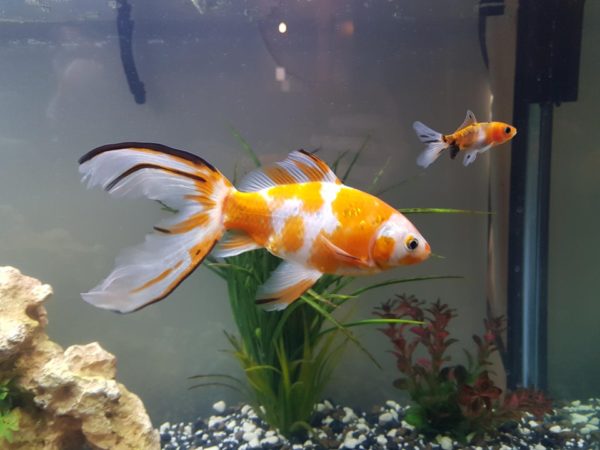
Just one shubunkin goldfish would need around 75 gallons! That means you would need a whole lot of room. This again backs up our suggestion of keeping them in a pond. Also, shubunkin goldfish are fast-growing, so you need to commit to an ample space right from the get-go. Keep no more than 2 shubunkins in a tank of 75 gallons. For an extra one, you would need to add another 75 gallons.
Maintenance And Care
They don’t need much from you in terms of tank maintenance other than cleaning. They do clean up well after themselves since they pick up leftovers. To keep them healthy, just make sure they always have clean water. Leaves and such could contaminate the water if the pond is outdoors, and their tendency to mess up the tank could soil water conditions as well.
To prevent the spread of diseases such as ich and swim bladder, you are looking at a 25% water change biweekly. They are prone to common fish diseases such as ich, swim bladder, fin rot, and more. Keep a close eye on your fish to make sure they are healthy. When they display signs of illness, it’s important to isolate them from the group until it has recovered to prevent the spread.
Suitable Tank Mates for Shubunkin Goldfish
Can Shubunkin live with goldfish? Speaking strictly about temperament, yes, they can. However, you need to be sure that the species you choose are not slow and timid because fish like these will have the food snatched right from them. Chances are slower and timid fish will not get to feed at all and possibly die of malnutrition; other goldfish, tetras, and certain catfish and barbs.
If you find that shubunkins are still dominating the tank and taking food from the other fish, you can feed them first towards one side of the tank then feed the slower and more disadvantaged fish on the other. However, you can avoid this disparity by adding other goldfish to the tank. Comets, koi, and fancy goldfish can more than match the energetic tendency.
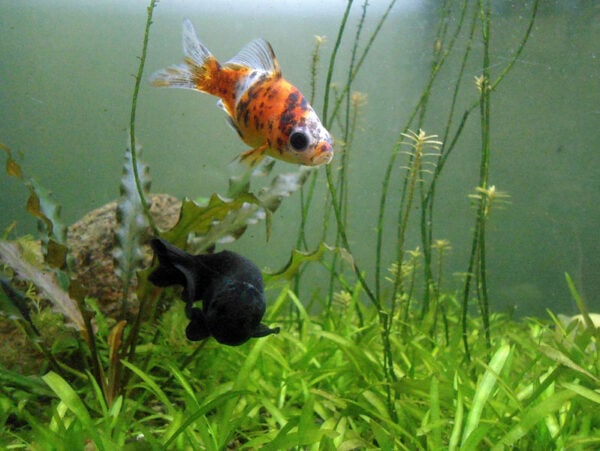
Other than fish tankmates, the Shubunkin can get along well with crustaceans and tank cleaners if you choose to add them to the tank. Larger tanks accommodate more graceful creatures living in harmony with the Shubunkin and make a good match. Be sure to steer clear of aggressive predatory fish such as cichlids, and the invertebrates you add to the mix should not be small enough for them to fit inside the mouths of your shubunkins.
You may easily get attracted to the Shubunkin goldfish’s stained and bright color patterns. Still, Shubunkins are a good aquatic pet as they have a social nature. Experts say they can easily coexist quite well with various tank mates.
Some Of The Best Tankmates For Your Shubunkins Are:
- Goldfish
Goldfish can be an excellent selection for the Shubunkins’ tankmates. As Shubunkins are giant goldfish, they can grow around 12 inches in length. The choice of other fish of that size can make a well-balanced tank. The comet goldfish can live with Shubunkins in a tank. Remember that these fish are fast, so don’t use slow goldfish.
- Mollusks And Crustaceans
Snails, crabs, and shrimps are some of the good choices for those who want to keep more than just Shubunkin in their aquariums. Shubunkins are not an aggressive type of fish, so they don’t cause harm to others. However, if you want to add mollusks or crustaceans to your aquarium, make sure that their size matches your Shubunkin’s size. A larger Shubunkin may consider a crab or shrimp as a snack.
- Koi
Both the Shubunkins and koi belong to the carp family. As they all share a similar lineage, Shubunkin and koi can get along ideally in an aquarium. They both socialize well, consume the same foods, and are friendly community inhabitants. On the other hand, both Shubunkins and koi fish look very similar, and in a large tank, they will look beautiful.
Incompatible Species
After going through the above discussion, it can be said that one should avoid aggressive and more prominent tank mates for their Shubunkin. For example, Tiger Barbs and Cichlids always view them as snacks. If you don’t have a Shubunkin large enough to stand against them, don’t add Cichlids and tiger barbs into the tank.
On the other hand, you will have to be careful while combining invertebrates and Shubunkins. Different freshwater shrimps, like Amanos and more, different freshwater shrimps are large enough to sustain, but the smaller species can face trouble. So, just use your common sense, and you will understand that.
Compatibility
For the least amount of stress and effort, we suggest shubunkin goldfish with others of its family. They all have the same temperament and attitudes that won’t require extra attention from you.
Breeding Shubunkin Goldfish
Again, these fish were bred in captivity, making it possible for aquarists to do the same at home. However, to ensure proper breeding, you would need a good number of fish between 4-5. If you remember what we said about tank size (75 gallons per 1-2 shubunkin), you can calculate how much space you would need for a group of that number.
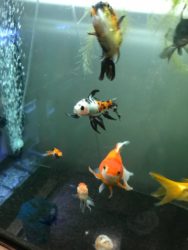
You would need more than one since they are a social fish that prefer to shoal. Much like the comet goldfish, there isn’t much effort needed on your part to trigger breeding. All you need to do is ensure that the water conditions are right, and the fish will do the rest. You need a separate space or tank (especially if you have other fish species in the tank) because you need to separate the parents from the eggs when laid.
Shubunkin fish tend to lay their eggs on surfaces, and a tank full of plants (artificial or natural) will be an excellent addition to catching the eggs. You need to lower the water temperature in the breeding tank to 60 degrees Fahrenheit (about 15-16 degrees Celsius), so you can see the tank will be colder than usual.
Your next step is to slowly increase the water temperature just a little bit day by day, 1-3 degrees each day, until you get to 72 degrees Fahrenheit (about 22-22.5 degrees Celsius). This will be a significant change to induce breeding since goldfish tend to breed in warmer waters.
To ensure the best conditions, always clean up leftover food (if there is any) from the tank to avoid spoiling the simulated conditions. Also, during this time, the fish will do well with a high protein diet of bloodworms and brine shrimp. When you start to see the males chasing the females around the pond or tank, you will know that you have succeeded, and breeding is about to happen.
Their colors will then become brighter and darken. The females will lay their eggs against the plants, about 10,000 in total. The males will fertilize them, and spawning will only take a few hours. Shubunkins, along with other goldfish, are terrible parents because they will then start eating the eggs, which is why you should separate the adults once the eggs are laid.
A week later, you should see the fry swimming around the breeding tank. Give them food small enough until they are large enough to fit brine shrimp and much larger foods into their mouths. You can reintroduce them to their parents when they grow to be about an inch or two.
Health and Disease of Shubunkin Goldfish
As mentioned above, Shubunkin is a hardy fish. However, sometimes they can develop a few diseases. And one of the common reasons behind this can be polluted and dirty water in the aquarium.
If your Shubunkins are swimming actively, digging in the substrate, and being active, they are in good condition. However, signs that can indicate some possible health issues are:
- Inactivity
- Not eating properly
- Bloody, ripped, or torn fins
- Not socializing with the tankmates.
- Red spots or sores on the skin
If your fish Shubunkins have white spot disease, you should immediately treat the aquarium with ich medication. If they have flukes, you need to add an antiparasitic medication to the water. Sometimes, they can develop swim bladder disease. When it happens, your fish will swim sideways or in a strange pattern. Primary reasons for this disease are poor nutrition, parasitic infection, constipation, and physical deformities.
You can treat this condition by offering them blanched peas. If that doesn’t work, then you should seek medical attention.
Are Shubunkin Goldfish Good for You?
There is no doubt that Shubunkins can be a trendy and beautiful addition to your outdoor and indoor aquariums. Their cost may range from just USD 3 to USD 20. So, you don’t have to break your bank to get a stunning calico pattern.
It may be noted that in some cultures, especially in China and Japan, Shubunkins are considered as a good luck sign. So, if you have a good-sized tank and a proper setup, then you can go for Shubunkin goldfish.
FAQ
Are These Fishes Easy To Care For?
Well, the regular care routine for your Shubunkin goldfish is relatively straightforward. They are hardy fish, so they don’t need regular maintenance. They can live and grow properly in captivity and can easily live in conditions that are not suitable for other fish.
How To Take Good Care of Shubunkins?
As Shubunkins are omnivorous, they can eat different flakes of frozen and fresh food. To care for your Shubunkin, you will have to maintain a perfect balance by offering them good quality flake foods. You should offer them tubifex worms, blood worms, daphnia, and frozen or live shrimp as a treat.
What Should Be The Minimum Water Level For Your Shubunkins?
For your first Shubunkin fish, you should go for a minimum of 30 gallons of water. And if you want to add more fish into the tank, then for each Shubunkin, you will have to add 10 gallons. A lower water level in your tank can affect their health. You can also use a 75-gallon tank for two Shubunkins.
Do Shubunkin Fish Hibernate?
Yes, Shubunkin goldfish hibernate. For that, your pond should be around 28-inch deep. Furthermore, there should be around 6-inch of the shallow area to let your Shubunkin propagate. It will be good for you to add a coarse composition in the bottom of the tank or pond as they spend a lot of time in the bottom.
Conclusion
Shubunkins are fantastic in a tank due to their easy care and hardy breed. Both beginners and experienced aquarists can be mesmerized by their unique colors and relatively affordable prices unless you find a blue one.
They do need a lot of space, but they can get along with many other species as long as you keep the food coming. If you have enough space, these fish can live for many years and are cheaper than the more expensive koi. These pretty creatures are available in most pet stores.
